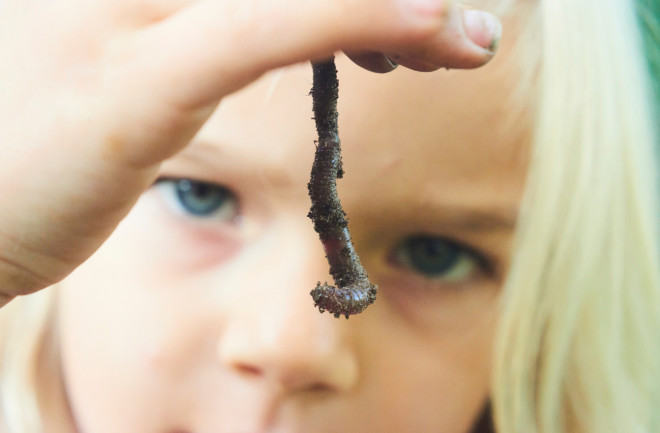Although dirt doesn’t seem to be particularly interesting on the surface — we often picture a lifeless, unremarkable substance beneath our feet — it’s actually a dynamic ecosystem teeming with organisms. And these organisms hold the power to make or break all of life on Earth.
One such unsung hero is the humble earthworm and, most importantly, its toilet habits. If you plop your spade into a patch of healthy soil, chances are that most of this is stuff that's come out the back end of an earthworm.
Earthworms are “ecosystem engineers” according to Kevin Richard Butt, an ecology professor at the University of Central Lancashire in the U.K. and an editorial board member of the European Journal of Soil Biology.
Read More: Medieval Friars Were Filled With Worms
Is Dirt Just Worm Poop?
By just going about their day — eating, burrowing, defecating — these invertebrates alter the soil around them and improve it in various ways. The main effect they have on the environment is through pedogenesis, aka soil formation.
Earthworms take mineral soil and digest any organic matter, such as fallen leaves, using microbe-filled guts and what Butt would consider “some sort of biological reactor.” From the organic matter, they extract the molecules they need for their own growth and reproduction, like nitrogen and carbon.
Mineral parts from the bedrock, which aren’t helpful for the worms, simply pass through and are ultimately amalgamated with organic waste through the worms’ mucus. Then, the creatures cast out friable material that is, to them, a waste product. We call it soil, however.
“And that's really what they do,” says Butt. “They make soil.”
Earthworm Castings: The Unsung Heroes
Charles Darwin, a great advocate of earthworms and one of the fathers of earthworm ecology, suggested back in 1881 that they process somewhere between 2 and 250 tons of soil per hectare per year.
In more recent observations, that number has changed to at least 40 tons per hectare per year. And, according to Butt, many worm species are capable of passing up to 30 times their own body mass of soil through their gut each day.
“One of the biggest questions that's been asked over the years and [is] still perhaps unresolved is, ‘What came first, the earthworm or the soil?’” he says. Earthworms help soil become healthy and healthy soils are good habitats for earthworms — so the process is cyclical. “It's a bit like the egg and the chicken,” Butt adds.
Plus, earthworm castings are just the tip of the iceberg when it comes to soil health; if they’re present, chances are there's a whole host of other important organisms in the soil that we can't see, such as fungi and bacteria.
But perhaps the next biggest things that earthworms are involved with are nutrient cycling and mixing up soil by burrowing among different ground layers.
Read More: Researchers Discover Tequila Worm Species
Three Types of Soil Worms
There are three main categories of earthworms, according to Tom Sizmur, a soil ecologist at the University of Reading who has dedicated his career to studying the intricate relationships between soil organisms and the environment.
First, those that tend to live on the soil surface, within the litter layer of forests and in the top few centimeters between tree roots. Second, horizontally moving earthworms dwell in the bulk of the soil and slightly deeper underground; they’re near the surface when it's wet, and deeper down looking for moisture when it's drier.
And lastly, there are deep burrowing earthworms, those that come up out of permanent vertical burrows at night to forage and then drag leaves or straw down into the soil.
All these different types of movements help aerate dirt, allowing for more oxygen to infiltrate below the ground and making space for roots to find their paths. This also prevents flooding by allowing water to percolate into the soil and filter down into the ground.
How Humans Stomped All Over Worms
Since the industrial revolution, however, intensive farming practices have really messed with the way earthworms benefit their ecosystems.
By constantly plowing through the land to plant crops, we’ve sliced earthworms in half, exposed them to predators, and broken off their burrows. By spraying pesticides, we’ve intoxicated worms and messed with the biochemistry of their ecosystems.
“Within agroecosystems treated in those more traditional ways, earthworm populations plummet and become almost nonexistent,” says Butt. But there are ways to correct these offenses, including a switch to regenerative farming practices.
Minimizing tillage and — rather than cultivating soil and preparing a seed bed — simply drilling the crops right in can be of benefit. Additionally, growing “cover crops” during the time of year when you wouldn't normally grow crops at all can protect the soil surface, pump more carbon into the ground, and improve soil health and earthworm health.
How Do Earthworms Help the Environment?
In the face of climate change and global warming, earthworms can play their part, according to Butt. “They're not the answer to everything, but they are the answer to some problems,” he says.
For instance, some soils that have been degraded through intensive farming could be given a new lease on life by adding earthworms.
But like most things in ecology, true rehabilitation is a matter of complex systems that interact with one another; in other words, it's a question of adding the most appropriate earthworms, properly, at the appropriate time alongside an appropriate type of organic matter — and appropriately managing the worms thereafter.
Butt’s dream is to see experts from various fields coming together to strategize how to implement these types of techniques moving forward. Because while dirt may be worm poop, we shouldn’t waste it.
Read More: Tiny Worms Got Stoned for the Benefit of Science

